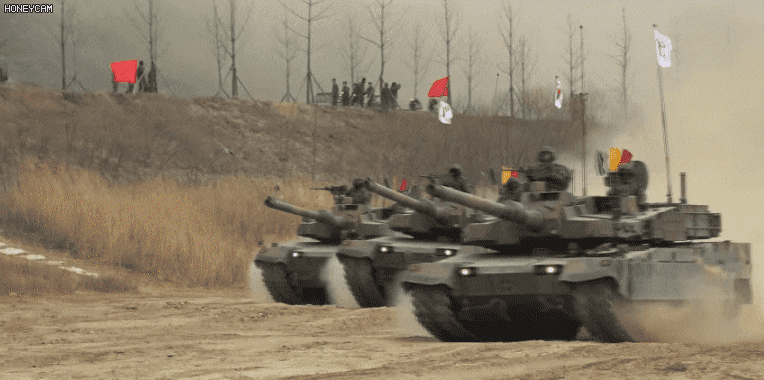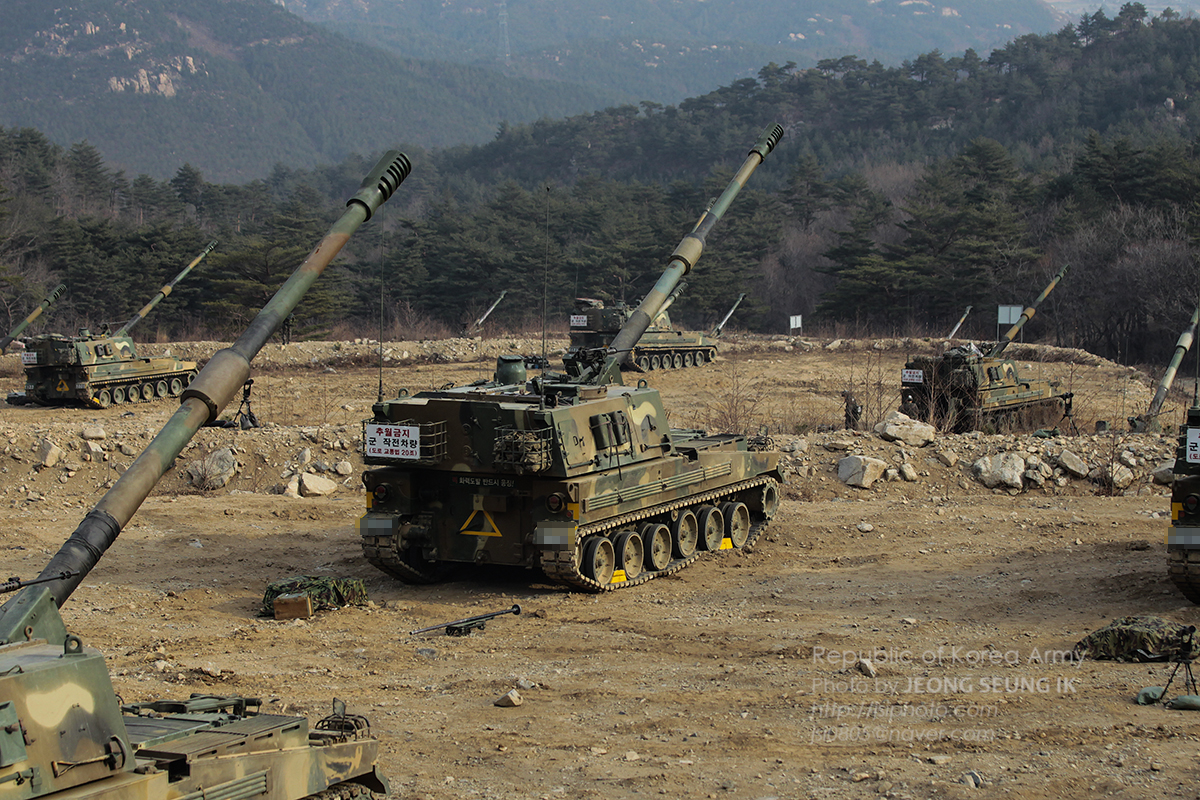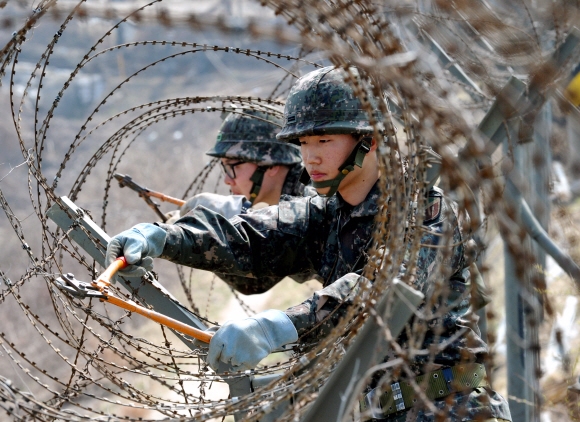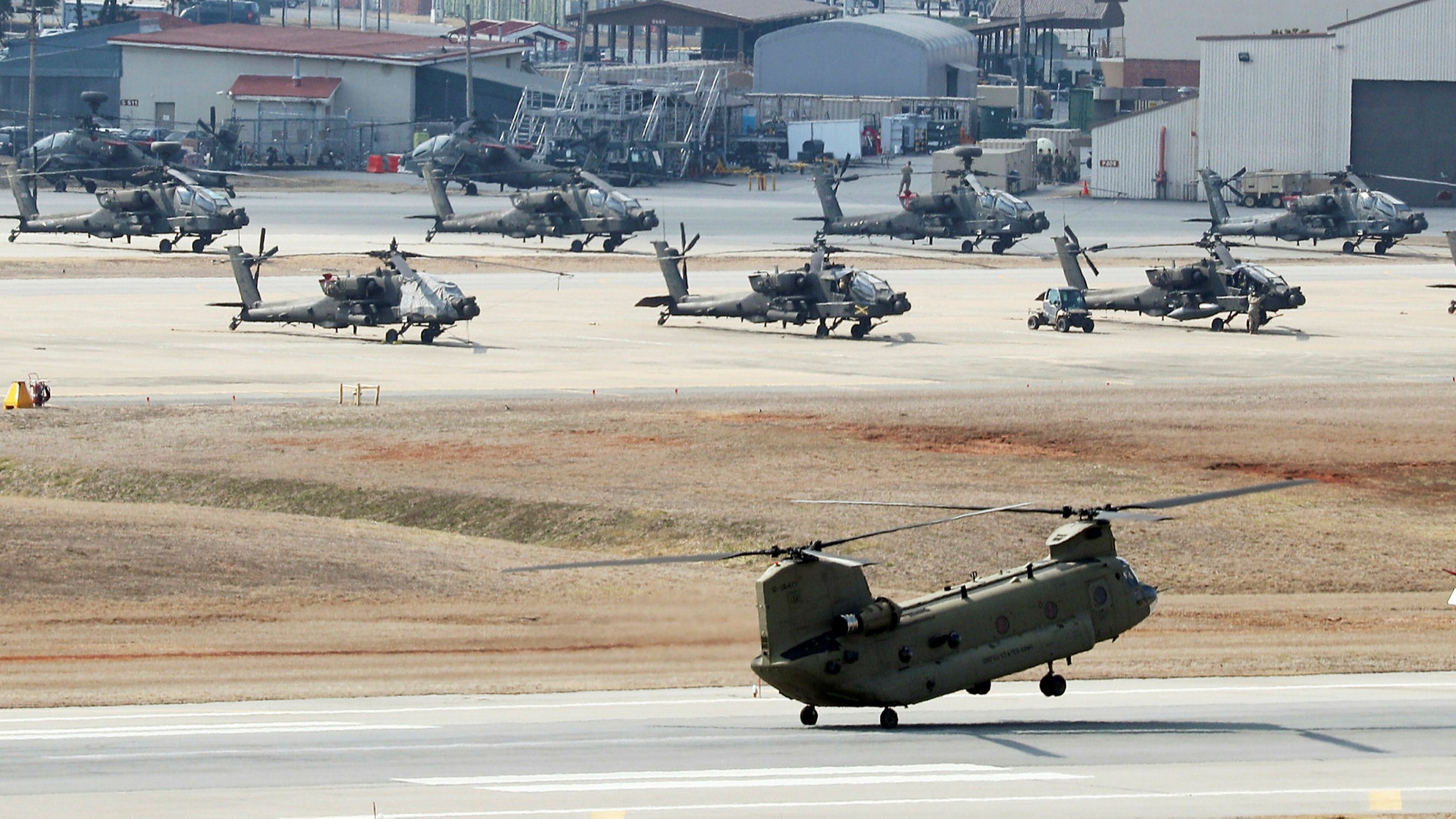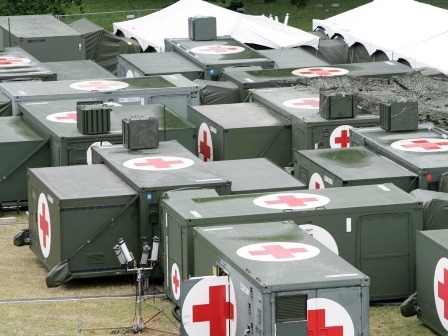- Oct 3, 2018
- 3,598
MISSION PLAN
File Information:
Name: Operation Plan 5029-KU [Unification]
Original Classification: Top Secret
Current Classification: Top Secret
File Name: CWDBH OPFTUOFKP
File Number: NSC/MND #0001
PREFACE FOR
OPERATIONAL PLAN TRAINING
5029-KU
OF
THE REPUBLIC OF KOREA
ARMED FORCES
OPERATIONAL PLAN TRAINING
5029-KU
OF
THE REPUBLIC OF KOREA
ARMED FORCES
---
This document is high classified, and shall only be accessed with explicit permission from the National Security Director, The National Security Council, the Minister of National Defense, or President Kim Daejung.
Preamble
Operational Plan 5029 (also referred to as: the Unification Security & Stabilization Force Plan) is an ROK plan and course of action with the intention of stabilizing the 250 kilometer Demilitarized Zone and the 1,352 kilometer Chinese-Korean border. The mission is to be carried out by the joint branches of the ROK Armed Forces. Under the legal context of the Constitution of the Republic of Korea and as authorized by the Joint Chiefs of Staff at the heading of the Blue House and National Security Council, the ROK Armed Forces shall take necessary action to ensure success of this mission. Based on the plans submitted by the Joint Chiefs of Staff, the National Security Council shall convene to formally approve Operation Plan 5029-U and as deemed necessary make appropriate modifications in the interest of the Republic of Korea and its citizens.
- Admiral Park Kyungjil, Chairman of the Joint Chiefs of Staff of the Republic of Korea
INTRODUCTION
1. Purpose.
The complete reunification of the Korean people and ensuring the appropriate resources delivered to respond to the massive humanitarian crisis developing in the North.
This operation, in combination with the mandate of the Korean Constitution and Unification Treaty shall be setforth to complete the total reunification of the Korean people and ensuring the appropriate resources delivered to respond to the massive humanitarian crisis developing in the North. This military and civilian operation will provide the basis from which the redevelopment and economic programs to revitalize the North's economy, integrate societies, and reduce the threat of conflict shall occur.
2. Background.
The collapse of China in the context of augmenting the collapse of the Soviet Union in the relationship and subsequent decline in aid to North Korea is crucial in the understanding of the current possibility and trajectory of the collapse of North Korea. National Intelligence Service intelligence reports on North Korea from the food aid delivery indicated to the National Security Council that port activity had declined by 140% and cargo vessels have no docked in over several months. The death of Kim Il-Sung in 1994 further increases the instability amongst political elites and the army. Whether power can be successfully consolidated in Pyongyang against the current economic crash, energy crisis, and famine is severely unknown. A power struggle will lead to the implosion of the states elites and subsequent trickle down into a collapse of the regime. While many foreign observers holding any conversations about the future of the regime always look at the resilience of the regime and its tools of maintaining control, the current situation is far more complex and concerning. The magnitude of problems associated with collapse, the complexity of mitigating them, and the serious dangers associated with mismanaging this effort all highlight the critical importance of advance planning for this contingency. Coordinated planning, particularly between the inter-branches of the Armed Forces, is essential to avoid massive loss of life among North Koreans and dangerous escalation between countries that might step in to stabilize the country after collapse. Government collapse in Pyongyang could create anarchy or a vacuum in which several serious problems might develop on the peninsula. These might include the disappearance of weapons of mass destruction (WMD) across international borders; a humanitarian disaster, and the potential for ongoing insurgency and violence. Hunger and insecurity could trigger a massive refugee crisis if North Koreans take flight in search of food and safety. In terms of the ROK's immediate concern, securing (WMDs), securing the frontline zone to ensure disarmament of artillery and combat divisions, preventing a massive transfer of North Koreans into the ROK, and maintaining a military capacity that can retaliate against acts of aggression by a foreign power and regional entities. The ROK Army can not send in convoys of food and medicine into anarchic areas without military escort and addressing the security apparatus (military, internal security, reserves) that could disrupt relief efforts must be coordinated. Addressing the humanitarian role in this crisis to stabilize North Korea requires direct military action.
3. Strategic Planning
The ROK Army Helicopter and Aerial Elements and Air Force will be used to deploy advanced elements of the ROK Armed Forces along the Korean-Chinese border and the ROK Navy to secure the maritime waters. The current range of troops per 1,000 people has been set at 13 ROK Uniformed Personnel per 1,000 persons in the North. This has been based on the data on the middle ground between a strong enough force to be a functioning military force and conduct efforts of humanitarian operations.
The total amount of troops to be deployed is expected to be 312,000 personnel drawing its personnel from the ROK Army, Marine Corps, Air Force, Navy, and Reserve Forces. The bulk of the operational force would come from the Reserve Forces which would contribute between 64-68% of the force. Operating under the legal framework of a state of emergency within the territories of the Republic of Korea and as outlined by the Constitution. Stabilizing the North would be done amongst tiers in which the first tier is securing the territorial borders of the nation, WMD sites, important government buildings, military bases, and the demilitarized zone. subsequently the next tier and phases would be disarmament, collection of weapons, and allowing the safe return of the reserve forces to their civilian life. The ROK Armed Forces would incorporate existing North Korean equipment into its arsenal for eventual disarmament. Because of the danger of anarchy in Pyongyang and the northern part of the country while the stability force works its way northward, the ROK Armed Forces shall deploy advanced units through aircrafts and helicopters and work with local units of the KPA to coordinate these efforts. The ROK Navy and Marine Corps shall work to create a stability force that stretches between two of the North's major ports Nampo and Chongjin and establish control over the lines of communication, and infrastructure.
Our major concern is that in the event of the North's collapse and any refugee activity, the Chinese would intervene in order to stabilize its southern border. The Chinese could if the collapse occurs without a pre-planned operations plan to move ahead of the ROK Armed Forces meaning the likelihood of confrontation and war. The collapse of the Chinese regime and its inability to reorganized effectively at this stage, the likelihood is limited. Secondly, if a peaceful transition occurs, the ROK Army and KPA can coordinate together and secure the border zone before announcing unification. The sense of mistrust between the ROK Army and KPA and other branches of the Korean Military units is a major issues that needs to be addressed. In any such joint-action, the KPA units would be absorbed into the ROK Command Structure and systematically demobilized over the period of the operation.
4. GOAL
- Reunification of the Korean Peninsula in line with the Unification Treaty
- Disarmament and Demobilization of North Korean Armed Forces
- Securing the border and zones of control across the Chinese-Korean and Russian-Korean borders
- Securing and maintaining rule and order in the reorganized five northern provinces
- Providing emergency medical and nutritional resources
- Cooperating and supporting the redevelopment of community civil emergency responses
- Restoring basic services and upgrading infrastructure and energy sector
- Fearing refugees and seeking to secure WMD, necessary military missions to stabilize North Korea under OPLAN 5029 a government collapse. Such missions include (1) stability operations to secure roads, provide public security, and deliver humanitarian relief; (2) finding, securing, and eliminating North Korea’s WMD program; (3) border control; (4) the disarmament of North Korean military forces, in order to disarm potential insurgents; and (5) a rapid reaction force standing by to deter or subdue any insurgent or military activity that might interfere with the provision of aid.
Date 1998 July 25
OPERATION
I. Force Composition
|
N/A |
Operation | Description | Personnel Required | Status |
Disarmament | The collection, safe storage, inventorying, and if necessary destruction of North Korean weapons systems, small arms, heavy artillery, and other items deemed appropriate by the ROK Armed Forces Command. The Disarmament of the North Korean Armed Forces inline with the demobilization clause of the Unification Treaty shall happen voluntarily and be a cooperative measure. The ROK Army will be responsible for seizing and storing the equipment, and after completing this shall inspect and inventory: the item, its current conditions, location, and then proceed to ensure its safe delivery to the ROK Command Base in Pyongyang for disassembly. | 25,000 | Complete |
Humanitarian Assistance | All branches of the ROK Armed Forces will be responsible for the delivery and providing of humanitarian assistance. Guidelines are handed out in booklets, ensuring adequate resources are distributed to improvised communities and those in need of assistance and help. The ROK Army and Marine Corps shall deliver medical and food through patrols and targeted deliveries. The ROK Air Force and ROK Navy will be responsible for the logistical aspects of transport. The ROK Armed Forces Medical Branch will be responsible for setting up temporary medical bases and facilities to assist in providing medical attention, nutritional advice, and assistance. | 7,000 | Complete |
WMD elimination | The ROK Army will secure all WMD sites and facilities to begin the process of elimination and destruction. The Army will raid and secure with highest priority WMD facilities to avoid the proliferation of WMDs to non-state actors or foreign regimes. | 3,000 | Complete |
Combat/Deterrence & Border Control | The ROK Army will immediately secure the ROK-Chinese and ROK-Russian Border and ensure that neither party can interfere or undermine ongoing efforts. These forces will patrol and maintain Korea's sovereignty over its borders. The disputed territories of the occupied portions of Mount Baekdu and Noktundo Island and shall resolve these occupied portions diplomatically. Korean Troops will secure all areas under the de-facto control of the former North's regime. | 14,000 | Complete |
Rule of Law and Coordination of Security Policy | The ROK Army will nominally assist with the rule of law and security coordination. The primary agency responsible is the Korean National Police Agency. The Police Force of 2,500 police officers drafted from the Police Conscripts will assist in policing major cities and integrating the Police Officers of the North. The Army will provide heavy assistance where needed and initially protect high valued areas. | 1,000 | Complete |
Casualties:
Republic of Korea Armed Forces | Republic of Korea Emergency Services | Civilians and Non-Combatants |
Designation | Location | Status |
ROK Armed Forces Bases
| Across the Republic of Korea
| OPLAN 5029-KU Complete | Regular Training and Operational Readiness |
Objective I | ROK Forces shall immediately deploy from the Demilitarized Zone through the agreed routes to begin stabilizing the DMZ from a refugee crisis. ROK Special Forces and Airborne Units shall be deployed to special locations to seize WMDs and secure airstrips and naval ports to allow the further deployment of troops and equipment. The KPA shall assist in the early phases of this planning and execution s well as augment as auxiliary forces. Local insight shall be produced by KPA personnel. The ROK Airborne Units shall further secure the Chinese-Korean & Russian-Korean Border and shall raise the ROK Flag across the border points to signify the territorial authority of the ROK Army over its territory. | Timeline: 24 hours for activation and departure, 48 hours for total completion of insertion | Complete | |||
Objective II (A) | ROK Personnel and Aircrafts shall be flown into Pyongyang, Wonsan, and other major zones of importance to begin unloading personnel and humanitarian aid, the ROK Air Force and Marine Corps shall secure all airfields and ports for use serving as entry of resources and assistance. | Timeline: 24 hours upon activation and 12 hours for completion | Complete | |||
Objective II (B) | The ROK Army and Marine Corps shall secure the physical borders along the North of the country and ensure the safety and stability of the area, the ROK Armed Forces shall coordinate ensuring the airspace and maritime borders are protected and maintained. | Timeline: Within 4 hours of completion of Phase OBJ I | Complete | |||
Objective III | ROK Medical Personnel from the Armed Forces and Civilian Entities shall begin deployments to provide emergency care and assistance, all of which shall be done in coordination of local contacts and personnel. NGOs and ROK Government shall coordinate food aid and resources for immediate deployment and a national campaign shall be conducted to raise capital and resources for the effort. | Timeline: Unknown | Complete | |||
Objective IV | The ROK National Police shall begin moving alongside other emergency services to provide assistance to the existing emergency and security forces in the North and relieve ROK Military personnel. ROK military personnel shall be diverted to disarmament and assisting KPA in regular functions of maintenance of borders and regions. | Timeline: 12 hours after completion of objective III | Complete [TR][TD] Objective V | ROK Joint Chiefs will meet with Operational Commanders to assess the impact of the mission, its efficiency, and its downside and shall address logistical issues continuously and then make plans for procurement of new logistical units and investment towards infrastructure efforts. | Timeline: 30 days after the operation | Active |
[/TD][/TR]
Last edited:






